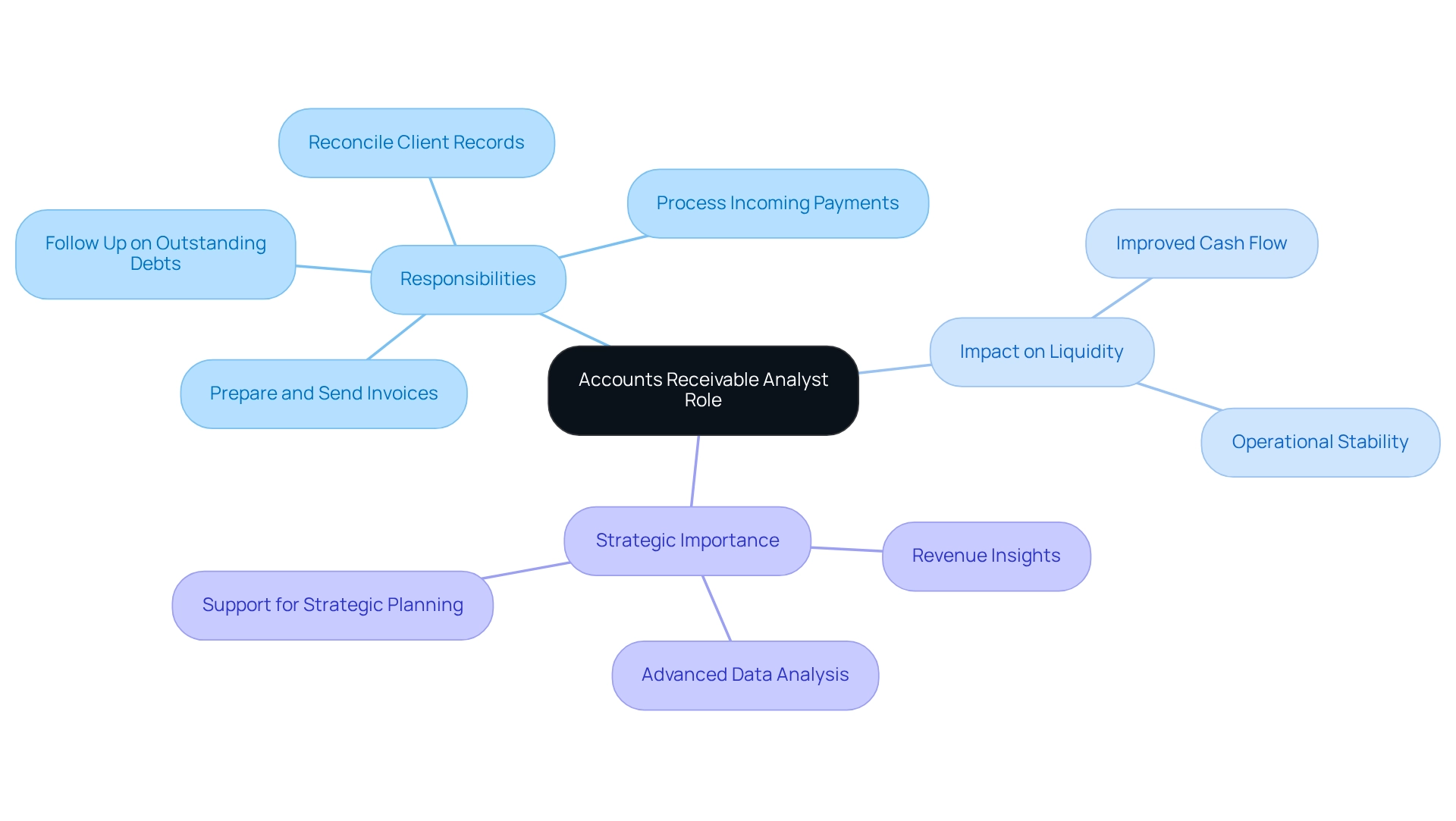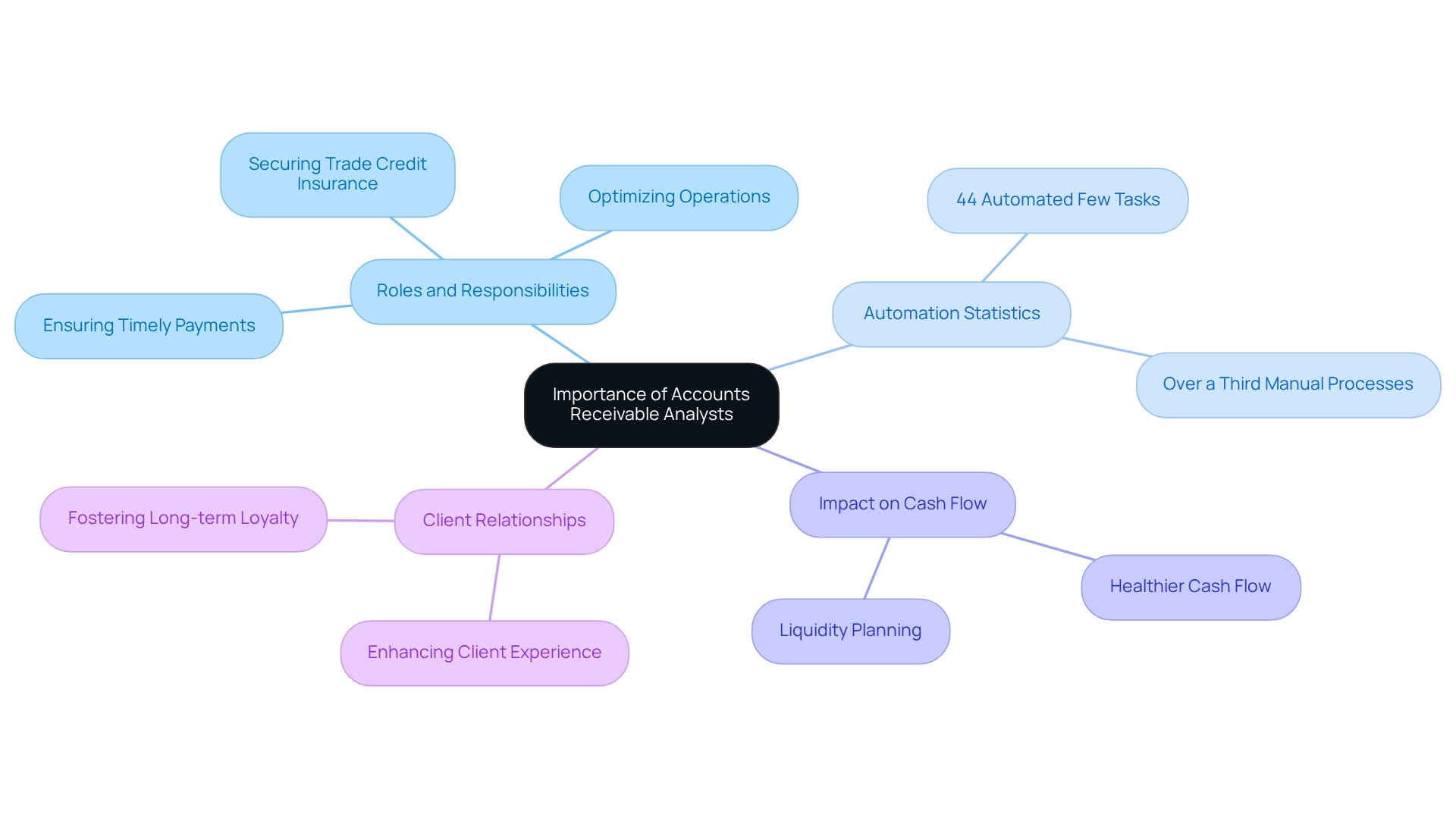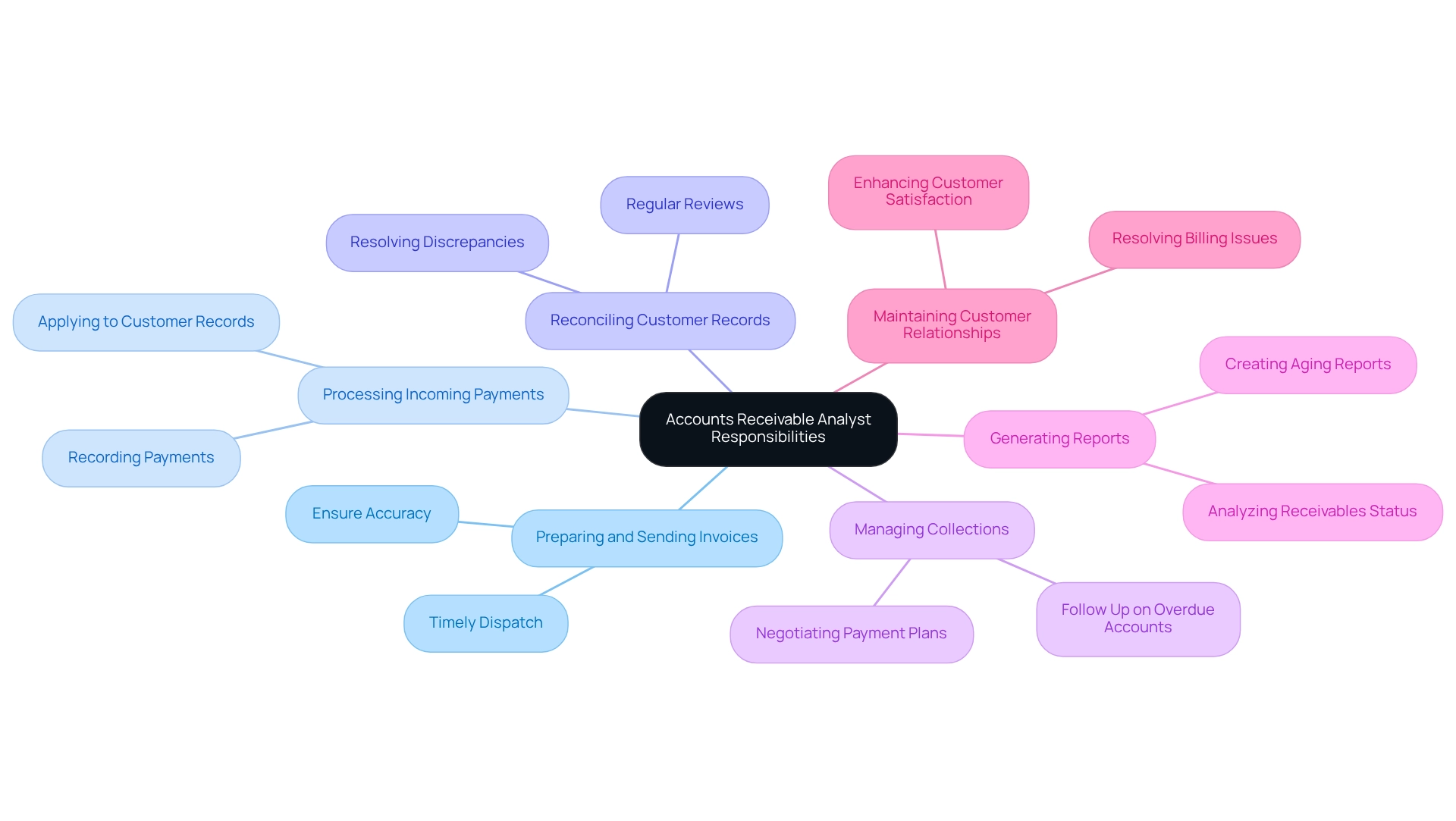Overview
The article articulates that the primary responsibility of an Accounts Receivable Analyst is to manage incoming payments, prepare invoices, and ensure accurate documentation. These tasks are essential for maintaining a company’s liquidity and financial stability. Furthermore, the article underscores the analyst’s significant role in cash flow improvement and client relationship management. It also highlights the increasing demand for advanced data analysis skills by 2025, illustrating the strategic importance of this position in today’s economic landscape.
Key Highlights:
- Accounts Receivable Analysts manage incoming payments and ensure accurate documentation of transactions.
- Key responsibilities include preparing invoices, processing payments, reconciling records, and managing collections.
- In 2025, the role has evolved to incorporate advanced data analysis for insights into revenue and liquidity.
- Effective receivable management can improve cash flow by up to 30%, emphasizing the analyst’s impact on financial stability.
- Analysts enhance client relationships and contribute to consistent revenue, crucial for organizational success.
- A bachelor’s degree in finance or accounting and 2-4 years of experience are typically required for the role.
- Proficiency in accounting software, analytical skills, and strong communication abilities are essential for success.
- Staying updated on financial regulations and engaging in training programs are important for career advancement.
Introduction
In the intricate world of finance, the role of an Accounts Receivable Analyst is pivotal, acting as the backbone of an organization’s cash flow management. As businesses navigate the complexities of a competitive landscape, these analysts ensure that incoming payments are processed efficiently and accurately, directly impacting financial health and operational stability.
With responsibilities that have expanded to include advanced data analysis and strategic insights, the modern Accounts Receivable Analyst is not merely a number cruncher; they are a vital player in shaping a company’s financial strategy.
This article delves into the essential functions, qualifications, and evolving significance of Accounts Receivable Analysts, highlighting their indispensable contribution to maintaining robust financial operations in today’s dynamic economic environment.
How does your organization leverage the expertise of these professionals to enhance its financial strategy?
Define the Role of an Accounts Receivable Analyst
The accounts receivable analyst job description involves serving as a vital monetary expert, tasked with managing a company’s incoming payments and ensuring the precise documentation of all transactions related to receivables. This role encompasses a variety of duties, including:
- Preparing and sending invoices
- Processing incoming payments
- Reconciling client records
- Diligently following up on outstanding debts
By ensuring prompt collections and minimizing overdue balances, the analyst significantly contributes to the organization’s economic well-being, directly influencing liquidity and overall business activities.
In 2025, the responsibilities of a Receivable Analyst have evolved to include advanced data analysis and reporting, providing insights into revenue patterns, customer behaviors, and potential liquidity challenges. This analytical approach not only enhances the effectiveness of collections but also supports strategic monetary planning.
The impact of Accounts Receivable Analysts on liquidity is profound; effective management of receivables can lead to improved financial flow and operational stability. As organizations face increasing competition and economic fluctuations, the accounts receivable analyst job description becomes even more critical in maintaining monetary resilience. Moreover, recent data indicates that companies with efficient receivable management can boost their cash flow by up to 30%, underscoring the importance of the accounts receivable analyst job description in monetary management.
In summary, the accounts receivable analyst job description highlights that this role is not merely a transactional position but a strategic role that plays an integral part in the monetary ecosystem of an organization, ensuring robust cash flow and the seamless operation of monetary processes.

Contextualize the Importance of Accounts Receivable Analysts in Finance
The accounts receivable analyst job description emphasizes the crucial role these analysts play in the economic structure of any organization, ensuring timely payments for goods and services—an essential factor for maintaining liquidity and operational stability.
In 2025, as companies navigate a competitive landscape, the effective management of receivables is increasingly acknowledged as a key differentiator. Analysts enhance client relationships and contribute to consistent revenue, directly influencing a firm’s financial well-being.
Notably, statistics reveal that 44% of companies have automated only a few receivable tasks, with many still relying on manual processes. This reality underscores the necessity for proficient analysts who can optimize these operations and facilitate a transition towards increased automation, highlighting the key responsibilities outlined in the accounts receivable analyst job description.
The impact of Accounts Receivable Analysts extends beyond immediate liquidity; their insights inform strategic decisions regarding credit policies and client engagement strategies. By securing accounts receivables through methods such as trade credit insurance, analysts play a critical role in maintaining healthier cash flow and enhancing liquidity planning.
This proactive approach not only safeguards monetary resources but also fosters long-term client loyalty, as their efforts significantly improve the client experience—crucial for promoting repeat business.
In summary, the accounts receivable analyst job description is essential for ensuring that organizations not only survive but thrive in today’s dynamic economic environment.

Outline Key Responsibilities of an Accounts Receivable Analyst
The primary duties outlined in the accounts receivable analyst job description encompass several essential tasks that are pivotal for effective financial management.
- Preparing and Sending Invoices: Analysts ensure that invoices are precise and dispatched promptly, a critical factor in facilitating timely payments and sustaining liquidity.
- Processing Incoming Payments: This task involves recording payments received and accurately applying them to the respective customer records, a fundamental step in the receivable workflow.
- Reconciling Customer Records: Regular reviews of customer records are essential to confirm that all transactions are accurately reflected, allowing for the swift resolution of discrepancies.
- Managing Collections: Analysts follow up on overdue accounts, negotiating payment plans when necessary to mitigate the risk of bad debts.
- Generating Reports: Creating aging reports and metrics aids in analyzing the status of receivables, providing valuable insights that inform management decisions.
- Maintaining Customer Relationships: Acting as a liaison between the company and its customers, analysts resolve billing issues and enhance customer satisfaction, which is vital for long-term business relationships.
In 2025, the average time taken to process invoices in finance departments has become a key performance indicator, with best practices emphasizing efficiency and accuracy. For the accounts receivable analyst job description, a Bachelor’s degree in accounting or finance is preferred, ensuring that analysts possess the necessary knowledge and skills. By adhering to industry standards, particularly in sectors such as food and beverage, companies can fortify their receivable processes, ensuring prompt payments and reducing credit risks. This meticulous approach not only facilitates consistent cash flow but also aligns with the latest best practices in receivable management. Furthermore, it is crucial to recognize that receivables refer to funds owed to the business by clients, while payables relate to the company’s obligations to suppliers and vendors.

Identify Essential Qualifications and Skills for Success
To excel as an Accounts Receivable Analyst, candidates must possess a blend of qualifications and skills that align with industry standards and the evolving demands of the role in 2025:
- Educational Background: A bachelor’s degree in finance, accounting, or a related field is typically required, laying the foundation for understanding financial principles and practices.
- Experience: Candidates are generally expected to have 2-4 years of experience in receivables or a similar monetary role, providing them with practical knowledge and insights into the field.
- Technical Skills: Proficiency in accounting software such as QuickBooks and SAP, along with advanced skills in Microsoft Excel, is essential for effective data management and report generation.
- Analytical Skills: The ability to evaluate monetary data, identify trends, and make informed decisions is crucial for optimizing accounts receivable processes and enhancing cash flow.
- Communication Skills: Strong verbal and written communication abilities are necessary for effective interactions with customers and internal stakeholders, ensuring clarity and fostering relationships. As noted by a taxpayer, “I was pleased with Meghan’s polite approach and her help in coming up with a workable payment plan.”
- Attention to Detail: A meticulous approach to managing records and transactions is vital to prevent errors and discrepancies, which can have significant implications for reporting and compliance.
In addition to these core competencies, staying updated with financial regulations, such as the Fair Debt Collection Practices Act (FDCPA), is increasingly important. Projections Central indicates that employment growth for receivable positions is expected to increase, reflecting the demand for skilled professionals in this area. For instance, organizations like the Tennessee Health System have successfully engaged with specialized firms like Boutique Recruiting for accounts receivable management, resulting in improved cash flow and operational efficiency.
Training programs that focus on these essential skills are also beneficial, as they prepare candidates for the challenges of the role. Overall, the combination of educational qualifications, relevant experience, and a strong skill set positions candidates for the accounts receivable analyst job description for success in a competitive job market. Boutique Recruiting is dedicated to sourcing qualified candidates for these roles, ensuring that financial firms find the right talent to meet their needs.

Conclusion
The role of an Accounts Receivable Analyst is undeniably critical in the financial landscape of modern organizations. By managing incoming payments, preparing invoices, reconciling accounts, and following up on outstanding debts, these professionals play a pivotal role in maintaining a company’s cash flow and financial health. Their responsibilities have evolved significantly, now incorporating advanced data analysis that informs strategic financial decisions and enhances operational efficiency.
Moreover, the significance of Accounts Receivable Analysts extends beyond mere transactional duties. They are essential in fostering customer relationships and ensuring liquidity, which are vital for sustained business success. As businesses continue to face competitive pressures and economic uncertainties, the ability to manage accounts receivable effectively becomes a key differentiator that can enhance overall financial resilience.
To thrive in this evolving role, aspiring analysts must possess a robust educational background, relevant experience, and a diverse skill set, including technical proficiency and strong analytical capabilities. As the demand for skilled professionals in this field grows, organizations must recognize the invaluable contributions of Accounts Receivable Analysts and leverage their expertise to drive financial success and operational stability in an ever-changing economic environment.
Frequently Asked Questions
What is the primary responsibility of an accounts receivable analyst?
The primary responsibility of an accounts receivable analyst is to manage a company’s incoming payments and ensure the precise documentation of all transactions related to receivables.
What are some specific duties performed by an accounts receivable analyst?
Specific duties include preparing and sending invoices, processing incoming payments, reconciling client records, and diligently following up on outstanding debts.
How does the role of an accounts receivable analyst contribute to a company’s financial health?
By ensuring prompt collections and minimizing overdue balances, the analyst significantly contributes to the organization’s economic well-being, directly influencing liquidity and overall business activities.
How have the responsibilities of accounts receivable analysts evolved by 2025?
By 2025, the responsibilities have evolved to include advanced data analysis and reporting, providing insights into revenue patterns, customer behaviors, and potential liquidity challenges.
What impact do accounts receivable analysts have on a company’s liquidity?
Effective management of receivables can lead to improved financial flow and operational stability, which is crucial for maintaining monetary resilience in the face of competition and economic fluctuations.
What does recent data suggest about companies with efficient receivable management?
Recent data indicates that companies with efficient receivable management can boost their cash flow by up to 30%.
Is the role of an accounts receivable analyst purely transactional?
No, the accounts receivable analyst role is not merely transactional; it is a strategic role that plays an integral part in the monetary ecosystem of an organization, ensuring robust cash flow and seamless operation of monetary processes.
